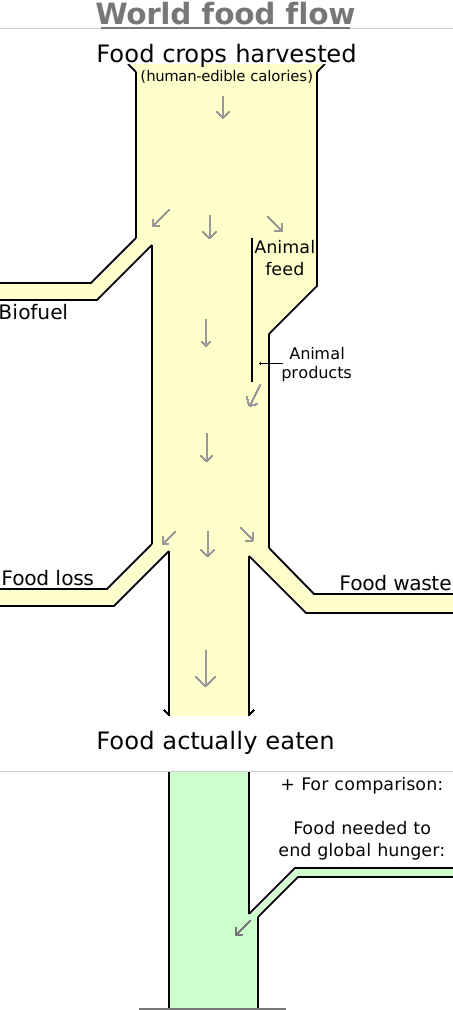Food: Difference between revisions
| Line 22: | Line 22: | ||
==Solutions== | ==Solutions== | ||
Even without any fundamental changes to food production, we can still end [[hunger]] and [[habitat loss]] by reducing any of the inefficiencies in the diagram above. What this means in practice: | |||
* Making food more [[plant-based]] | * Making food more [[plant-based]] | ||
** Reducing ''animal consumption'' to its [[maximum sustainable animal consumption|sustainable limit]] | |||
* [[food waste|Reducing food waste in various ways]] | |||
* Not burning food as [[biofuel]] | |||
Other things that would help: | |||
* Improving [[crop yields]], especially in poorer countries. | * Improving [[crop yields]], especially in poorer countries. | ||
* [[Gardening]] and suburban farming. | * [[Gardening]] and suburban farming. | ||
* [[ | * Greener ways to grow crops - such as [[regenerative agriculture]] - as long as [[crop yields]] are ''not'' reduced. | ||
Things that | Things that could help in the future: | ||
* [[Lab-grown meat]] | * [[Lab-grown meat]] | ||
Things that | Things that probably won't help: | ||
* [[Vertical farming]] | * [[Vertical farming]] | ||
* More [[grass-fed beef]] | * More [[grass-fed beef]] | ||
Revision as of 17:46, 24 August 2022
The world currently struggles to feed everyone sustainably. But this doesn't have to be the case. There are enough resources to feed our growing population - if resources are used efficiently & ethically.
Problems
Current food-related problems include:
- Hunger & malnutrition
- Nearly 900 million people lack calories or protein (1 in 9 people worldwide).
- Even more people lack vitamins & minerals, even if they get enough calories & protein.
- Environmental impact
- Habitat loss, due to agriculture using so much land.
- Methane emissions, such as from cows.
- CO2 emissions from fertilizer production.
- Pollution from pesticides and fertilizers.
- Animal cruelty
- Particularly bad in factory farms, which are the source of most animal products.
These problems are magnified by inefficiency:
Solutions
Even without any fundamental changes to food production, we can still end hunger and habitat loss by reducing any of the inefficiencies in the diagram above. What this means in practice:
- Making food more plant-based
- Reducing animal consumption to its sustainable limit
- Reducing food waste in various ways
- Not burning food as biofuel
Other things that would help:
- Improving crop yields, especially in poorer countries.
- Gardening and suburban farming.
- Greener ways to grow crops - such as regenerative agriculture - as long as crop yields are not reduced.
Things that could help in the future:
Things that probably won't help:
- Vertical farming
- More grass-fed beef
- Organic monoculture
Q&A
Unanswered
How much animal protein could be produced from pasture only, if no crops were ever fed to animals?
How much CO2 is released for every km^2 of deforestation?
How much CO2 is released for every km^2 of destroyed grasslands?
How much carbon does every km^2 of newly-grown forest sequester per year?
How much carbon does every km^2 of newly-grown grasslands sequester per year?
Bottom line
All 8 billion people could be well-fed & healthy, without destroying the planet, and without anywhere near as much harm to animals. But all of this requires both personal changes and systemic changes.
